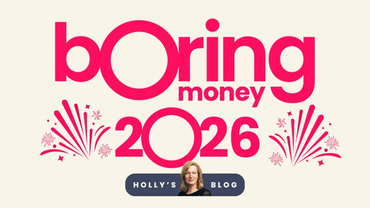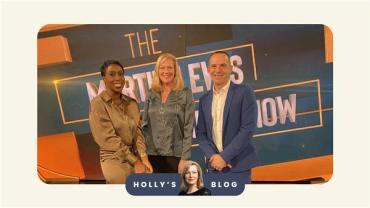If the England footie team were investments...
By Holly Mackay, Founder & CEO
12 July, 2024

This week, apart from the incessant rain, the talk of the town is of course England’s place in the finals of the Euros. I was comfortably dozing on the sofa on Wednesday when the pundits shouted, the dog barked and my heart temporarily stopped as Ollie Watkins boosted July GDP numbers by ensuring we will collectively spend an estimated £400 million on beers and pizza on Sunday. And that’s just me! 🐷
In the spirit of national pride, this week’s blog considers which investments our footballers would be, if they lived in an ISA and not a mansion in Essex. Stick with me on this one, as I bring you Holly’s Portfolio Construction Guide for footie fans.
We start with my favourite, the little cutie that is Bukayo Saka. He is tech stock Nvidia in 2024 – you simply cannot afford to substitute him or have him on the bench. He ain’t cheap but some things are worth paying for.
Next up, it’s Harry Kane. He is the FTSE 100*. Composed of relatively old parts. Unflashy and perhaps unfairly lamented when on a global stage. Often a source of pain for us Arsenal supporters (I use the label ‘supporter’ loosely), but he does have his moments and will pay out dividends when the bright young guns are imploding around him. Arguably unwise to ignore him.
Jordan Pickford is what gold would look like it if chewed gum. (Does this irritate anyone else?) When everything else is letting you down and the world is uncertain, it's solid and admirable under pressure, called upon to save things when the chips are down. When the aliens invade, or Trump shouts at North Korea, you want a stash of Jordan Pickford hidden under the bed. Metaphorically of course. You can buy gold funds, or exchange-traded funds (iShares Physical Gold was a best-selling ETF in June on 3 leading platforms), or even hold gold in an online vault with the Royal Mint.
Turning to Kyle Walker, he's Unilever. Not in my portfolio. Although performance has been decent and he pays dividends, he has too many unauthorised sub-brands with too many partners for my risk appetite.
Bellingham is the (very expensive) global index tracker fund. He covers lots of regions and has performed reliably well with flashes of brilliance, notably the stock market bicycle kick in late 2023 as the tech sector led the US to strong gains and global tracker funds soared. A worthy foundation stone of any portfolio. Unlike Bellingham, most tracker funds should cost you in the region of about 0.10% a year. For example, Fidelity Index World, which has been in the best-selling DIY investor fund lists for ages, costs 0.12% a year and has about 1,473 companies in it from around the world.
Disturbingly described as “well fit” by my daughter – and I don’t think she’s articulating his cardiovascular capacity – Phil Foden is my India fund. He has been increasingly influential whilst not scoring goals – he does well regionally but not so consistently on the world stage, but he’s undeniably a powerful performer having a good year. The Jupiter India fund is a bestseller on 3 major platforms.
I nominate Declan Rice as my multi-asset fund**. He's absolutely everywhere, not likely to get singled out for praise, but is a versatile player who gets the job done and is a core holding (and a nice looking young man – he can make up half of my pension any time 😂).
Not everyone can be a striker. I nominate Stones as the bond fund in the portfolio – solid, reliable when volatile team mates are down, but not going to win a game on his own. I would have to check if Stones also had a mad, unusual bender the month of Liz Truss’ disastrous mini-budget, but it would make my bonds analogy even better! If he did – he’s back on track now, and with interest rates due to come down, bond prices should go up. Buying UK bonds (‘gilts’) remains a super tax-effective and low-risk option for wealthier people who have maxed out their ISAs and used up any Personal Savings Allowance.
Guéhi is like cash (but harder to say). His job is to defend. And defend he does. He’s arguably not the top-paying savings account (for example, Chase currently pays 5.1% on an easy access cash account), but he will probably be a lot better than your high street bank’s current account and doing a decent job.
Finally, to the man of the moment. In my imaginary football portfolio, Ollie Watkins is like crypto was in 2019. No-one apart from keen footie fans has really heard of it, bringing it on is risky, but you own it for 5 minutes and BOOM. It remains to be seen whether you bag the profits and leave it on the bench in the next match, or keep backing your bet and bring it back for (hopefully) more.
All these assets need direction. So let’s turn to England manager Luis de la Fuente – oops, sorry forgive that presidential slip. I mean Gareth Southgate. Gareth is an active fund manager. He carefully selects his team, going underweight some big names and taking chances with others. Lots of passive fund fans shout at him for his selection and think he’s hugely disappointing. For most of the tournament he was like Terry Smith in 2024, leaving Nvidia out of his Fundsmith team, but on Wednesday night he outperformed the index with some clever portfolio reweighting. His asset allocation on Sunday will be keenly watched!
For those of you who hate football and haven’t the foggiest what I’m on about, or if you have 5 minutes in between beers and pizzas, we spoke to financial advisers and experts this week to analyse what the new Labour government could mean for pensions, tax and investments. Or those keen to learn more about investment markets and opportunities may like to watch this video from this week’s sponsors, the managers of the Mid Wynd International Investment Trust, on compounding and the economic law of competition.
Have a great weekend everyone and good luck to my portfolio! All together now, Sweeeeet Caroliiiiine…
Holly
* FTSE 100 is the collection of the 100 largest companies in the UK you can buy shares in. You can get them combined into one single product using something called an Exchange-Traded Fund or ETF.
** Multi-asset funds are like ready-meals – they combine a bit of everything and offer people low-maintenance, simple ways to buy one thing whilst being well diversified under the bonnet.

Want to get Holly's weekly blog straight to your inbox?
Already have an account? Login






